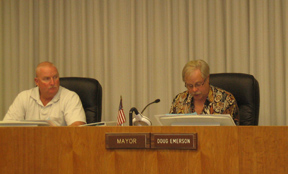
Legal challenges end move to redraw districts
Voters will need to wait until at least 2011 to decide the issue
of an elected mayor and new district boundaries after a consultant
informed city council members at a July 28 meeting that it would be
impossible to draw four districts that meet legal requirements.
Legal challenges end move to redraw districts
Voters will need to wait until at least 2011 to decide the issue of an elected mayor and new district boundaries after a consultant informed city council members at a July 28 meeting that it would be impossible to draw four districts that meet legal requirements.
“It’s pretty obvious we have no choice,” said Mayor Doug Emerson, who was appointed to the position. “To make a decision to do this now would be foolhardy.”
If the mayor is elected at large – meaning everyone in the city can vote for that office – the city council needs to have an even number of seats so that there is a possibility for majority votes.
For nearly a year a group of citizens, including Tony Ruiz, a former political science professor, and Gordon Machado, a county planning commissioner, have been working with the city council to approve a ballot measure for the November 2008 election that would allow citizens to directly elect the mayor. Hollister’s mayor is currently appointed from one of the five city council members, though most cities in California have direct elections for the office.
“I was part of the citizen committee that came forward,” Machado said. “We thought it would be the right move and most people agree it is valid.”
He said the members of the committee assumed the demographer would be able to make it work.
“The demographer has proven that it is not feasible to do this at this time,” Machado said. “Therefore I concede.”
The city council members directed Jeanne Gobalet, of Lapkoff and Gobalet Demographic Research, Inc., to come up with four districts from the five existing ones.
But drawing district boundaries for elections isn’t as simple as it seems, Gobalet said, as she went over some of the legal requirements that must be met.
Hollister went to district elections in 1989 at the urging of the League of United Latin American Citizens’ legal counsel. Lulac had sued other cities in the region, including Watsonville, for disenfranchising the Latino population. Since then, two of the five districts in Hollister have a majority of registered voters that are Latino. Currently, three of the five council members are Latino.
The problem Gobalet encountered with creating a district map is that 2000 census data has to be used, and the districts cannot be gerrymandered – or oddly shaped – based just on racial or ethnic guidelines.
Latinos make up 55 percent of the population in Hollister, but only 39 percent of the registered voter population, which added to the difficulty in drawing the boundaries.
“The Latino population is a bit younger,” Gobalet said. “Because of the age mix and at the time [ of the 2000 census] there were lower citizenship rates and voter registration.”
Gobalet drew up three draft plans for redistricting, but said each map had some problems that could open the city up to legal actions.
“These raise serious problems,” Gobalet said. “It would be very expensive. Any change at this point using data from 2000, you could face serious legal action even if everyone loved it and voters approved it.”
Gobalet pointed out that outside groups could bring complaints to the Federal Bureau of Justice.
Mickie Solorio Luna, the president of SBC Lulac, spoke of just such a possibility during the public comment period.
“The city gained district elections without being sued,” Luna said. “We worked together. Now as we approach this it is concerning that these district-elected council members would be willing to take a step back in history.”
She mentioned a recent lawsuit brought against the city of Modesto for violating the Voting Rights Act.
However, it was clear from the beginning of the discussion that each city council member, though, in favor of putting the elected mayor issue on the ballot, were against redistricting in a way that opens them up to legal challenges.
“The intent was really about having an elected mayor,” said Monica Johnson, a council member. “We wanted a strong center leader everyone could go to who would have the interest of the city at heart.”
By law, the city districts will need to be redrawn in 2011, based on the 2010 census data.
“2011 is a long way away,” Emerson said. “I would hope in the coming years that the committee stays together and Lulac can be involved until we have a consensus. I’d like to look at all possibilities.”









